It takes just one bad scare to change how your horse behaves from then on – for days, maybe months, maybe years, maybe forever. With observation, management and training, you can alleviate some of your horse’s fear, but you might not be able to “fix” it. I’m in this situation with Tonka.
Tonka hates static shocks. They scare him. They make him angry. They’re one of the few things that make him suddenly react and try to flee. All winter I spray him with various products so that doing normal, daily things, like removing a blanket, putting on the saddle pad, and brushing him, don’t shock him. But using these products isn’t failsafe. Tonka got zapped in January, and I’ve been trying to mitigate the fallout ever since.
Tonka had perfect behavior in the cross-ties.

Grooming and tacking up in the aisle had been something that we did without much thought.

Cross-ties shouldn’t be so securely attached to the horse and wall that they’re unbreakable. You never want a horse to get hung up on ropes, or to fight restraint until hurt. The cross-ties at this barn are attached to the walls on loops of baling twine, so that a horse that pulls back can break free. The cross-ties used are also a safety version – the straps are held together with velcro. It takes a lot of force to rip the velcro, but it will come apart.
Back in the fall, when Tonka’s sacroiliac issue flared up, he let me know by going backwards when I went to buckle up his girth. He easily broke the baling twine, and then stood still because he knew that he had made his point. It wasn’t a big deal, and it didn’t change his behavior. But baling twine is sometimes nylon rope, not natural jute. At the end of January, on a particularly dry and cold day, I tacked up Tonka and, pleased with him, pat him on the neck, near his ears. I was wearing gloves. ZAP! He looked like this (old photo, but descriptive.)
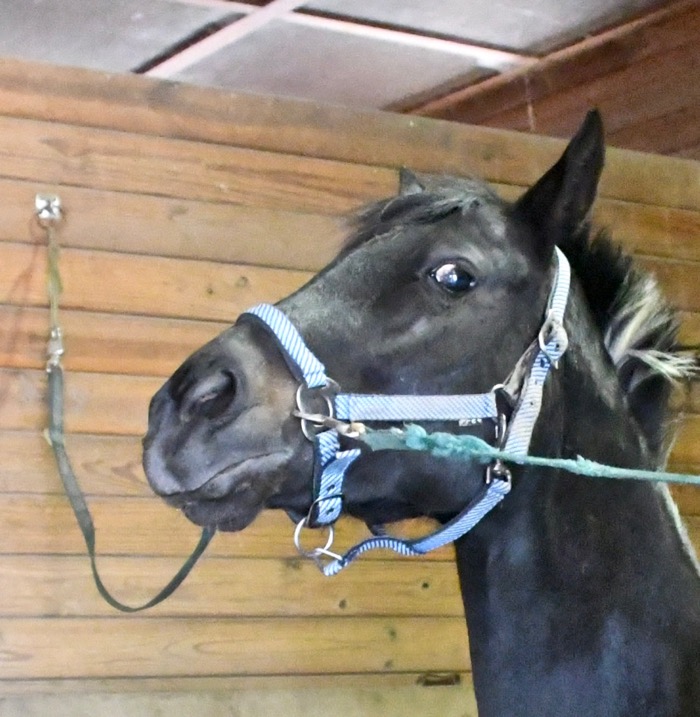
This time, although he was leaning into the cross-ties, they didn’t break because the loop was strong, synthetic twine. Now the fear of the static shock had changed to panic about the pressure on his poll. To escape that, he tried harder at what had worked before – pulling back. The velcro ripped open. Two feet of velcro coming undone makes a loud noise, which added to Tonka’s fear. When the ties gave, he flew backwards, as if flung out of a slingshot. Going in reverse is not a natural flight behavior for a horse. Their instinct tells them to run forward. So, the very act of hurling backwards down the aisle added to the fear. Altogether, this entire event lasted less than ten seconds.
Tonka is an easy-going horse who isn’t easily rattled. I thought that those ten seconds would be it. But a few days later, I thoughtlessly reached my hand up to pat his neck. It was the exact motion that had caused that zap that started the scary cascade. Once again, Tonka reacted by throwing his head up, once again, there was pressure on his poll. This time, though, he tried to get out of the situation with more force from the get-go. The cross-ties ripped, and again, he flew backwards.
The repercussions were immediate and lasting. The next day, Tonka showed fear when asked to simply stand, untied, where the cross-ties were. If I reached my right hand up in a certain motion, his head flew up and I could see the whites of his eyes. Any pressure on the side buckle of his halter made him tense. Time didn’t improve the situation. A few days later, his reaction was the same.
I deal with these sort of issues with my students. Now I was my own client. In situations like this, I ask, “where is the threshold?” – which is asking where the fear begins. Behind that threshold is where I begin the training. Tonka was nervous in the aisle, so we couldn’t work there. We started in his stall. I bought used cross-ties at my favorite consignment tack store.
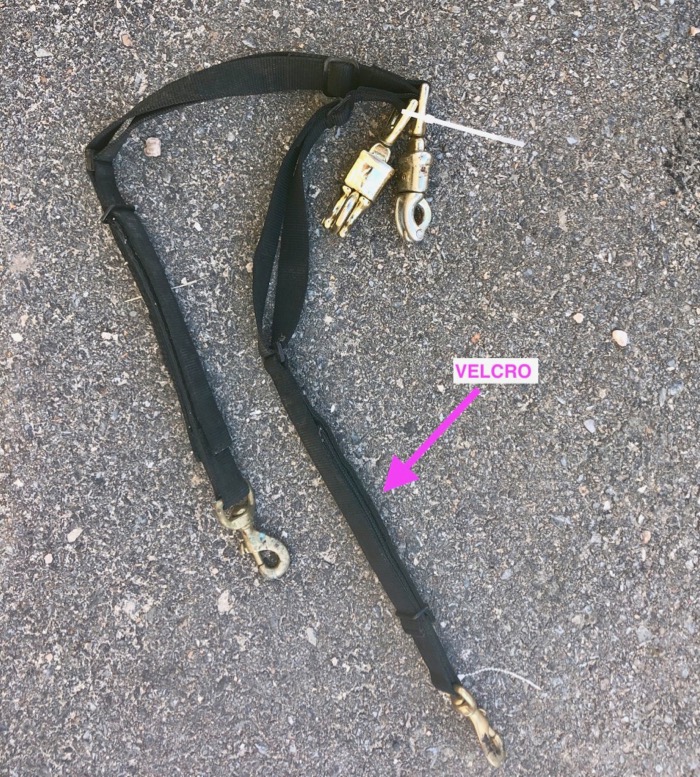
I began to ask Tonka questions. Do the sight of these scare you? He was wary but not over threshold. A cookie while looking at the cross-ties changed what he thought about them. Then I added the sound of the snap.
Next, Can I attach them? It turned out that he didn’t mind the cross-ties snapped to the loop under his chin, but if I reached towards the side buckle, he eyeballed them. So, I worked on getting him nonchalant about that motion.
Now he looked forward to seeing and hearing the cross-tie. Next, could I attach it and add that small bit of pressure that comes from holding his halter still? Slowly, we got to yes.
But those questions weren’t the only ones. Tonka had always enjoyed being scratched under his mane,
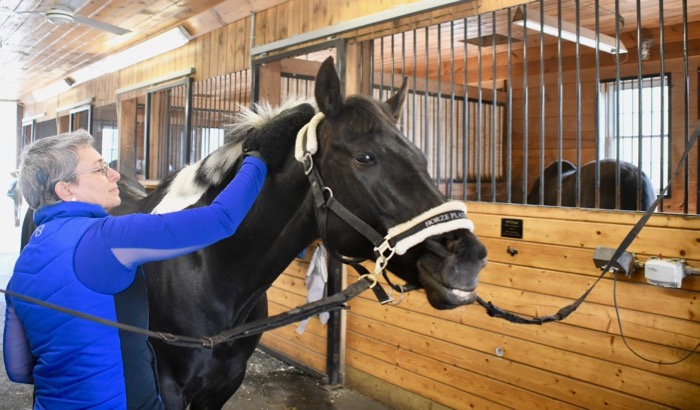
until this incident changed that. When I reached towards his neck, he looked scared. So, I carefully built up his confidence about what would happen when he saw my hand appear anywhere at eye height. Because I needed to do this carefully and thoughtfully, I had to stop patting him, “just because,” which made me realize how many times I reach over and touch my horse. I was in the habit of patting (slapping?) him frequently. I’d be annoyed if someone did that to me! So, I have to relearn some things, too.
I asked Tonka questions in his stall until the answers were usually Yes, that’s fine. Then I moved into the aisle, and asked the same questions.
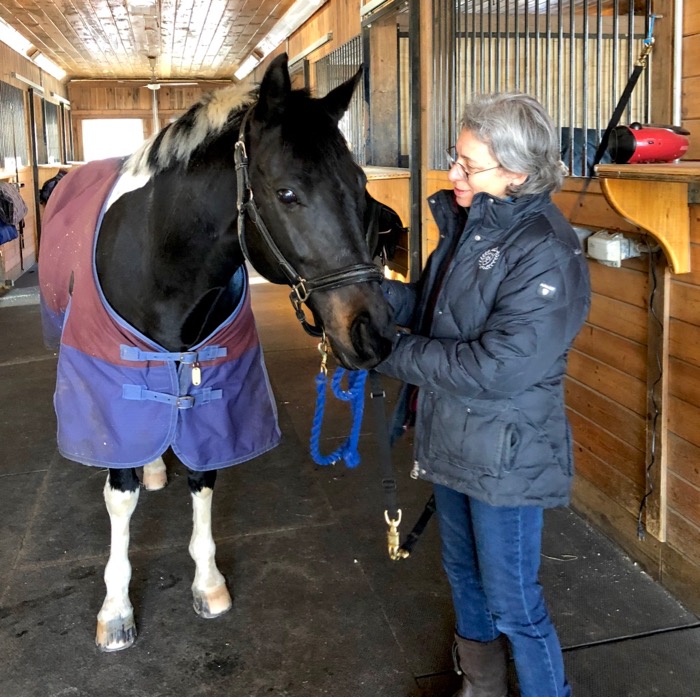
The process was made easier because Tonka ground ties.
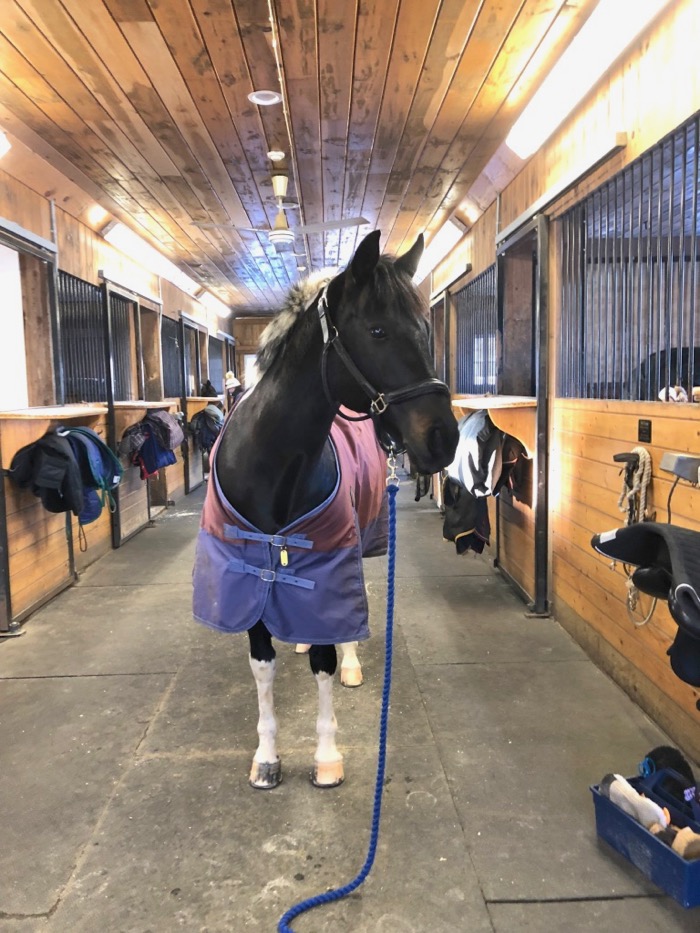
In the aisle, the answers were more hesitant, so I went slower. At first, all we did was stand in the scary place while he ate carrots and hay pellets. Then, I showed him the cross-ties, using the same motion as if I was about to attach them. That worried Tonka. So I broke that down into smaller increments, until it the answer was I’m okay with that.
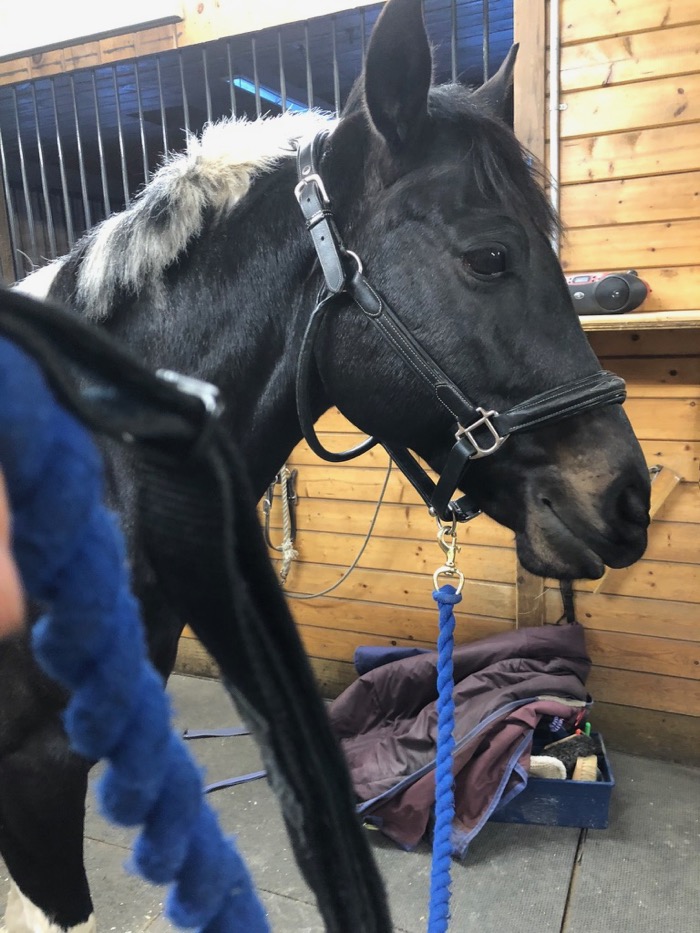
Once he was calm with the cross-ties near his head, I still didn’t want to cross-tie him in the aisle. Instead, I moved into the grooming stall. Managing the environment can make training more successful. In this space, if Tonka backed up, the wall would stop him. I attached my cross-ties to the ones already there. That way, even if he backed up to the wall, there’d be no pressure on his head. I started with the lead rope still on him – the cue to stand still. I added one cross-tie and gradually built up the time that it was attached to his halter.
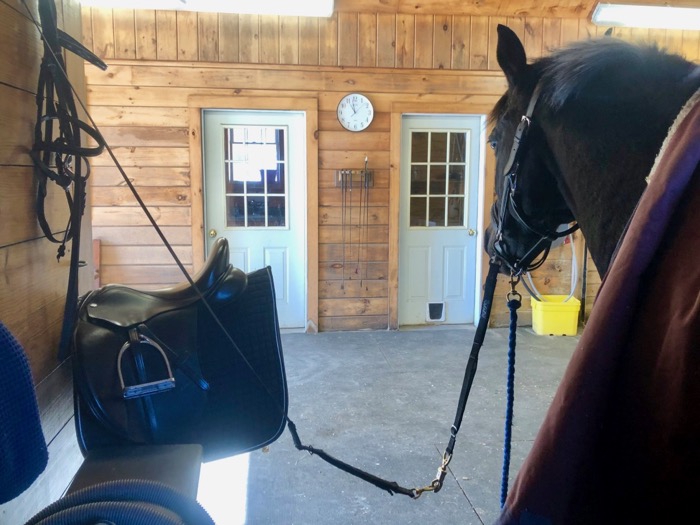
I did this for a couple of days, and then added the second cross-tie.
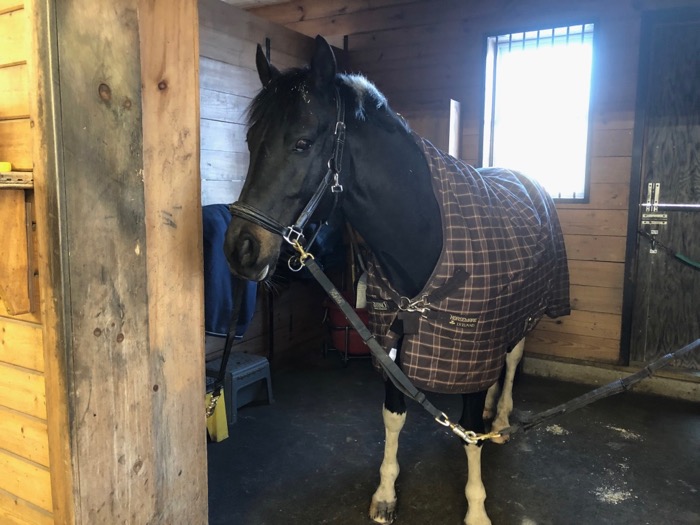
I still haven’t done this in the aisle. That’s because there’s another component that I became aware of during this training.
Tonka has always resisted pressure on his poll. When I pull on the halter, instead of immediately stepping forward with me, there’s always been a slight hesitation or resistance. Sometimes it’s more obvious!
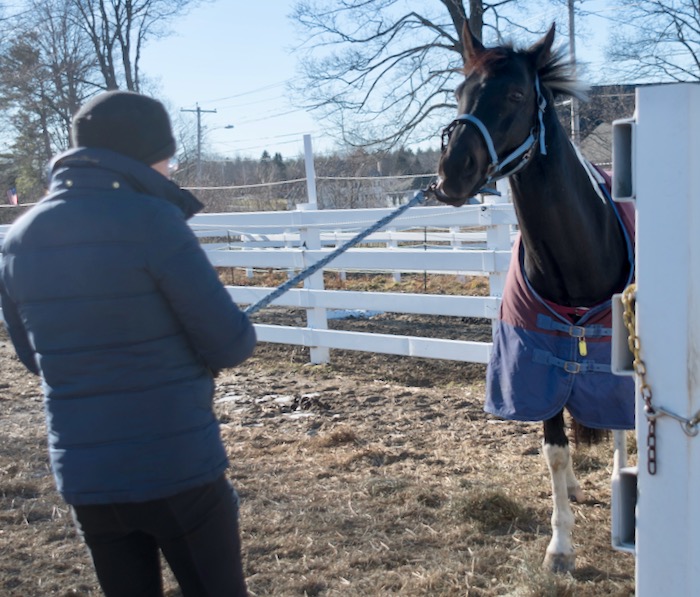
Because much of what I do isn’t pressure/release but is go forward to something good, this hasn’t been a problem. I wait a second and he follows, or, I use a hand target to get Tonka to move. The people who handle him at the barns have never complained, so it isn’t something I’ve addressed. Now is the time. Tonka needs to learn that any pressure behind his ears should be met eagerly by lowering his head a tad, and by stepping forward to alleviate the pressure, not backing against it until it stops.
Once again, I started in the stall. Hand on halter. Light pressure applied, and as soon as he gave a millimeter, a reward of a cookie.
This piece of the puzzle is not difficult to retrain, and I think it’s going to be key to keeping him from getting into scary scenarios on the cross-ties. Prevention is always the best option. We’re making progress, but fear is a wild card. I’ll be managing the environment, being observant to avoid the triggers, rebuilding his trust about my movements around him, and training so that Tonka gives to halter pressure. I don’t think about this sort of work as having an end, rather, it’s a new landscape to nurture.
Some good has already come of all of this. I’ve already stopped energetically patting Tonka while saying good boy. That was for me, an outlet to express my pleasure at being around him. He never really liked it. Not even when paired with carrots. Although the patting has stopped, he still gets carrots. Tonka says, Let the training continue!


He’s so much like my Lexi. She was terribly head/bridle/ear shy when I got her. I got her so she would eagerly reach for the bit and pick it up out of my hand (after months of slow, careful, positive reinforcement). Then I accidentally pinched her ear last November. She’s been side-eyed and reluctant since then. We’re working on it and it’s getting better, but she’s slow to trust. One tiny mistake sets us back days or weeks.
Thanks for your always thoughtful and informative blog posts. I learn from each one.
Good for you to be thoughtful and sympathetic. Sometimes, changing the place or equipment can help to reduce the fear. Tonka had issues with lunging, and one thing that reduced that was switching to a different lunge line.
thank you for sharing the details of how you break things down, and how you look for thresholds. very helpful.
Glad you found it a worthwhile read.
I had a horse flip over backward in cross ties after the barn owner’s pet turkey came through the entrance and shook his feathers at my mare. She backed, felt the resistance and pulled hard enough to flip when the cross ties broke. Since then I’ve saddled and done most work with my horse while holding a 12 foot lead. When i need to tie like when I’m trimming hooves, I use a Tie Blocker so the horse can pull back against resistance if she feels the need.
I trip over those 12-foot leads 🙂
I hope that she wasn’t injured when she flipped! That’s scary.
Wonderful blog, so informative, shows what can be achieved with patience and understanding 🙂
Thanks, Jan.